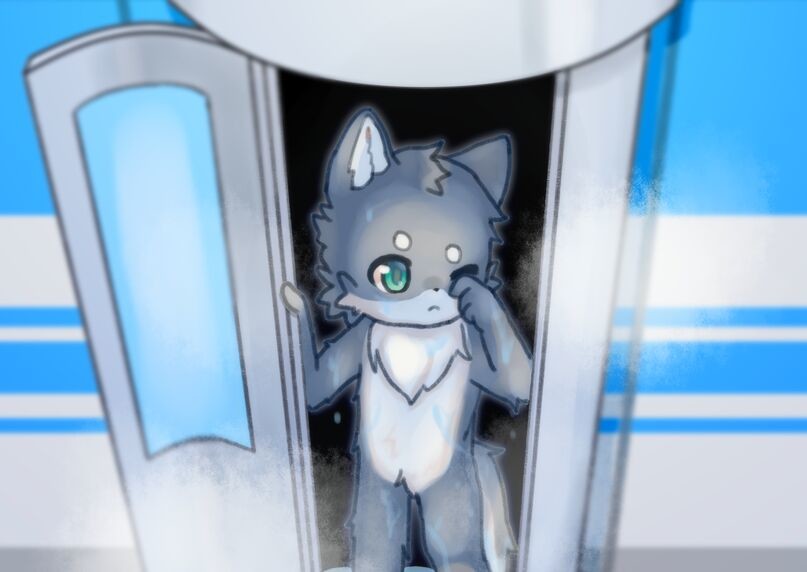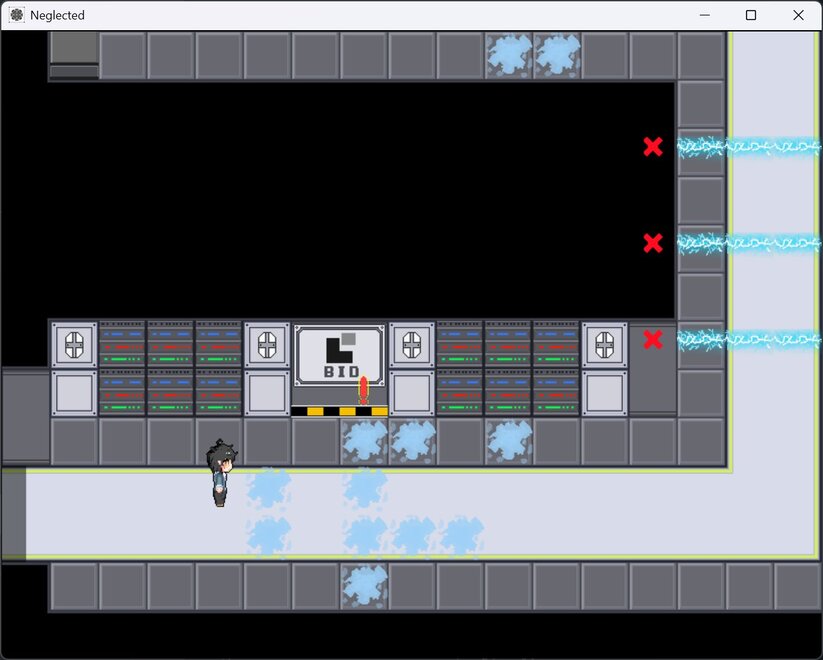Neglected - 5/10
After completing Neglected, I realized an awkward truth: I couldn’t even remember the protagonist’s name. Checking back on the Steam page, I learned his name was Glen—a name I failed to form any emotional connection with during my 4-hour playthrough. This story of a human and two anthropomorphic characters escaping from an underground research facility should have been a journey about trust and redemption, but instead devolved into a torturous marathon of endless box-pushing puzzles and chase sequences.
Steam page: https://store.steampowered.com/app/1300360/Neglected/
Price: Free
20 Minutes of Story, 4 Hours of Padding
Neglected’s plot can be summarized in one sentence: Human Glen and two anthropomorphic animals escape a mysterious facility together. That’s it. No further details. This core narrative isn’t entirely without potential—amnesiac anthro animals, an accidentally involved human, an adventure to escape oppression—but the game invests almost no effort in fleshing out these characters.
The game does attempt to establish worldbuilding through environmental text—virus outbreaks, the facility’s secret experiments, human-anthro relations—scattered across documents and terminals in various rooms. The problem is that this background information is neither deep nor focused enough, and more critically, it has extremely weak connections to the characters themselves. You can read reports about virus outbreaks, but they don’t help you understand Glen’s or the anthro’s circumstances, much less translate into empathy for the characters’ fates.
Character dialogue is even more scarce. For over half the game, the three protagonists act separately—Glen pushes boxes here while the two anthropomorphic companions wait for rescue there, or vice versa. Even after the trio reunites, dialogue remains extremely sparse. You remember they’re escaping, but not who they are or why are they escaping—the game doesn’t even clearly explain how the human protagonist ended up here. Story beats feel like they exist solely to unlock the next puzzle rather than facilitate meaningful character interactions. There’s virtually no casual conversation or sense that they care about each other’s situations; no moments that allow players to understand these characters’ personalities or build emotional connections.
More damning still, this story that should take 20 minutes to tell is forcibly stretched to 4 hours. So what fills those 3 hours and 40 minutes? The answer: box-pushing, more box-pushing, even more box-pushing, and insane chase sequences. The game attempts to manufacture “playtime” through masses of repetitive puzzles, but duration itself is meaningless—when players mechanically move blocks in the twentieth box-pushing room, they won’t develop any concern for the characters’ fates, only the exhaustion of wondering “when will this end?”

In-game footage. Credits: Steam page
Gameplay: From Tedious to Infuriating
The game’s core mechanics rely almost entirely on these elements: box-pushing puzzles, chase sequences, and mazes. The first few rooms seem reasonable enough, but you quickly discover these are the only gameplay elements—for a full 4 hours, you’ll push similar boxes onto similar buttons in countless nearly identical rooms, or dodge electric orbs and electrified floors. Endless repetition. By mid-game, I stopped thinking about puzzle logic and just numbly executed the standard procedure of “find boxes, push all boxes onto all buttons.”
Worse still are the chase sequences. These chases follow the “one-hit kill + die-and-retry + precision micromanagement” formula, possibly the design most likely to infuriate players in indie games. You must dodge electric orbs or electric floors in maze-like corridors, with margin for error decreasing as you progress: one wrong step means restart, 0.5 seconds of slow reaction means restart, and often the game automatically restarts when you least expect it—timed hazards hit you without warning.
The final boss battle pushes this frustration to its peak. After over an hour of repeated attempts, when I finally succeeded, I felt no sense of achievement or joy—only the relief of “thank god it’s finally over.” This isn’t Dark Souls-style “death as learning,” just pure torture from poor design decisions.


Visuals and Audio: Limited Bright Spots
The investment in Neglected’s audiovisual presentation is obvious, which makes the game’s subsequent problems all the more regrettable.
The game’s environmental design has a nostalgic aesthetic reminiscent of early Flash SNS games, with soft colors and unified style. The opening district overview map especially, with its carefully arranged scene details and atmospheric creation, initially gave me high expectations for this game.
Character portraits and cutscene illustrations are equally polished and delightful—quite commendable for a free indie production.
The soundtrack is another pleasant surprise. The background music has beautiful melodies and appropriate emotional rendering, with well-designed sound effects for tense scenes. If you only listened to Neglected’s OST, you might think this was a quite refined indie game—unfortunately, even the best soundtrack cannot salvage terrible gameplay and hollow narrative.
However, these strengths actually make the game’s other problems more glaring. When you see that beautiful district map in the opening, you expect the subsequent adventure to be equally excellent—but soon, this expectation will be ground down by endless box-pushing and chase sequences. The excellent audiovisual presentation is like beautiful wrapping paper, but what’s wrapped inside is a disappointing core. The developers clearly invested tremendous effort in art and music, but these efforts cannot compensate for deficiencies in core game design and narrative.

In-game footage. Credits: Steam page
Punitive Ending: A Mind-Blowing Logic Collapse
The game’s most frustrating design is undoubtedly its ending mechanism. Neglected has multiple ending branches, but their trigger conditions and presentation are disastrous.
The game only tells you in the very last scene that you need to collect exactly ten crystals to remove the “self-destruct collars” from the companions’ bodies, or they will explode after being taken from the laboratory.
Let’s pause and consider how strange this setup is: “collars inside their bodies”—shouldn’t collars be worn around the neck? Why are they “inside the body”? Why does it require exactly ten crystals to deactivate? Won’t nine work? What would happen with eleven? Does this number have any narrative significance? What’s the relationship between the crystals and the deactivation device?
Clearly, this is a contrived excuse for hidden collectibles. The problem is that this excuse is so far-fetched it actually makes you more aware that this is purely a game mechanism rather than an organic part of the story.
Many excellent games have “no full collection = bad ending” designs—Hollow Knight, Undertale, and Celeste all have similar mechanics. But in these games, collectibles are either directly related to character growth, have reasonable narrative explanations, or at least let players feel the meaning of collecting during the process. And Neglected? Crystals are scattered in various corners with no hint system, no collection progress display—their existence is purely to set a hidden “good ending threshold.”
When you’ve endured 4 hours of box-pushing torture, countless death restarts, finally cleared that awful boss battle, and enter the ending full of anticipation, only to watch the two companions be abandoned because of “self-destruct collars”—and you had absolutely no idea the game had such a collection requirement—the feeling isn’t “I want to make a different choice,” but “this game is mocking me.” This doesn’t encourage replay; it only enrages players. I don’t want to experience those terrible levels again; I just want to stay away from this game.
Comprehensive Mediocrity Without Strengths
Neglected’s biggest problem is that it has no real strengths. Project Oasis, though technically crude, at least had an engaging story; Neglected has neither outstanding narrative nor interesting gameplay, and even its characters are portrayed as faceless.
Yes, the game’s art and music are good—but these can only add points to a game, not become the core supporting the entire experience. When players numbly dodge electric orbs in the tenth electrified floor room, even the most beautiful soundtrack only makes them more aware of the boredom they’re experiencing; when characters deliver personality-less dialogue accompanied by exquisite portraits, the contrast only becomes more jarring.
The game attempts to tell a story about the “neglected,” and ironically, the story itself neglects the most important thing: making players care about these characters. I don’t remember Glen’s name, don’t remember the two furry friends’ names, don’t even remember how they treated each other—because the game never gave me a reason to care about them.

Verdict
Neglected is a comprehensively mediocre work. It lacks the contradictory charm of Project Oasis’s “obvious flaws but genuine bright spots,” instead offering a more disappointing blandness—you can see the creator’s effort in art and music, but you can also clearly feel the weakness in game design and narrative. A hollow story paired with torturous gameplay makes it hard to generate interest whether the protagonists are human or anthro characters.
If you’re interested in this game’s art and music, you might try the first 30 minutes to experience the atmosphere—but be prepared: the next 3.5 hours will be a struggle against terrible level design, and the ending may make you feel none of it was worth it.
I wanted to give this game a positive review. After all, I could feel the creator’s sincerity and effort. But when, after enduring all that torture, I was forced to watch a punitive bad ending because I hadn’t collected all 10 crystals, all goodwill evaporated.
Score: 5/10 - Mediocre
Neglected barely passes on a technical level but completely fails at the most important thing: “letting players enjoy the game.”